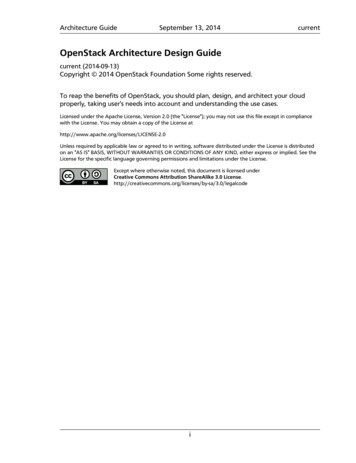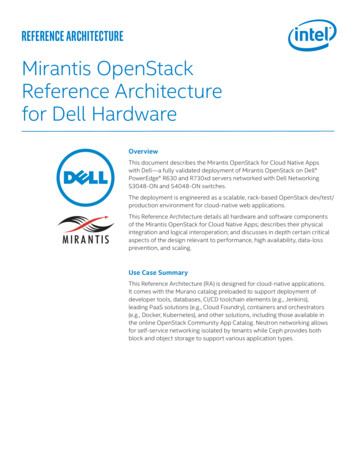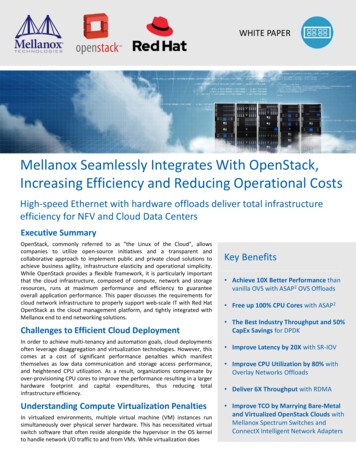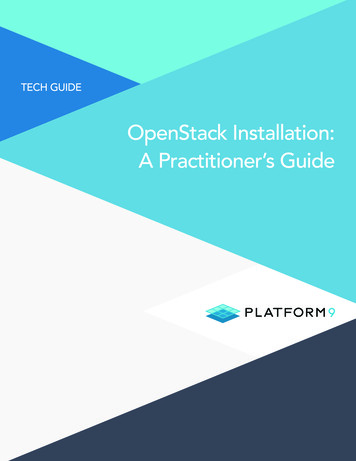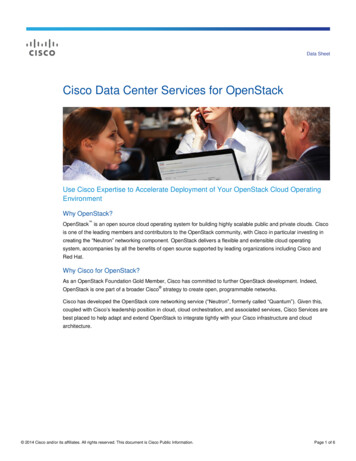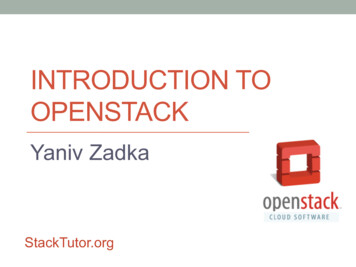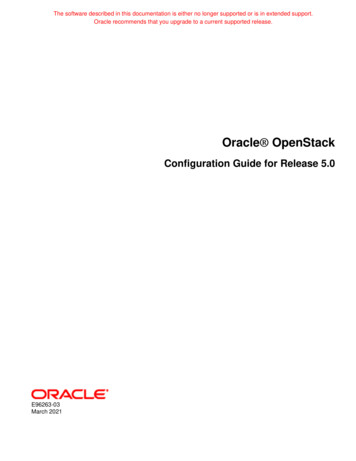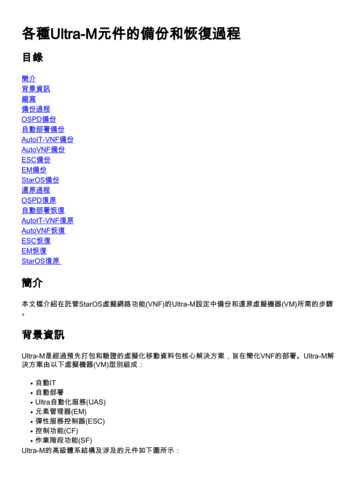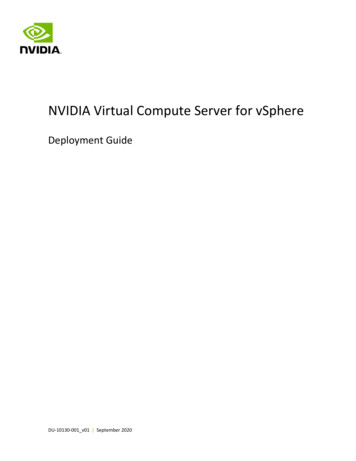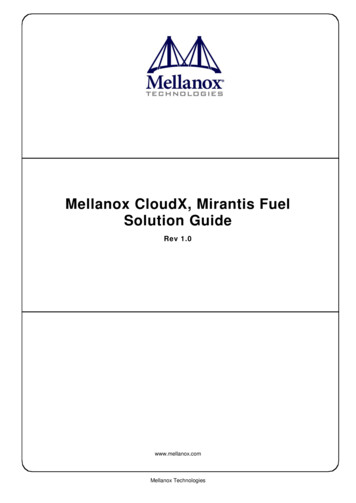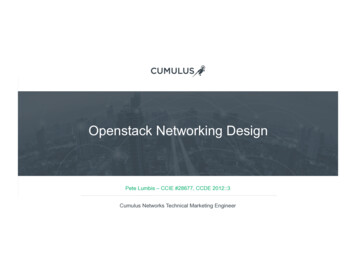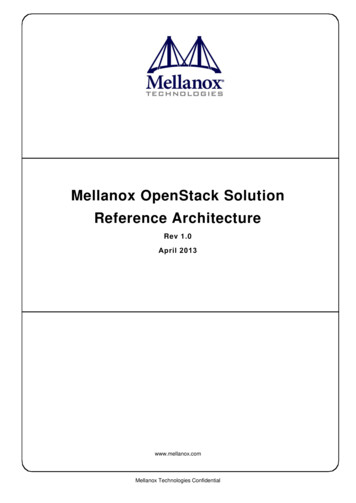
Transcription
Mellanox OpenStack SolutionReference ArchitectureRev 1.0April 2013www.mellanox.comMellanox Technologies Confidential
NOTE:THIS HARDWARE, SOFTWARE OR TEST SUITE PRODUCT (“PRODUCT(S)”) AND ITS RELATED DOCUMENTATION AREPROVIDED BY MELLANOX TECHNOLOGIES “AS-IS” WITH ALL FAULTS OF ANY KIND AND SOLELY FOR THE PURPOSE OFAIDING THE CUSTOMER IN TESTING APPLICATIONS THAT USE THE PRODUCTS IN DESIGNATED SOLUTIONS. THECUSTOMER'S MANUFACTURING TEST ENVIRONMENT HAS NOT MET THE STANDARDS SET BY MELLANOXTECHNOLOGIES TO FULLY QUALIFY THE PRODUCT(S) AND/OR THE SYSTEM USING IT. THEREFORE, MELLANOXTECHNOLOGIES CANNOT AND DOES NOT GUARANTEE OR WARRANT THAT THE PRODUCTS WILL OPERATE WITH THEHIGHEST QUALITY. ANY EXPRESS OR IMPLIED WARRANTIES, INCLUDING, BUT NOT LIMITED TO, THE IMPLIEDWARRANTIES OF MERCHANTABILITY, FITNESS FOR A PARTICULAR PURPOSE AND NON INFRINGEMENT AREDISCLAIMED. IN NO EVENT SHALL MELLANOX BE LIABLE TO CUSTOMER OR ANY THIRD PARTIES FOR ANY DIRECT,INDIRECT, SPECIAL, EXEMPLARY, OR CONSEQUENTIAL DAMAGES OF ANY KIND (INCLUDING, BUT NOT LIMITED TO,PAYMENT FOR PROCUREMENT OF SUBSTITUTE GOODS OR SERVICES; LOSS OF USE, DATA, OR PROFITS; OR BUSINESSINTERRUPTION) HOWEVER CAUSED AND ON ANY THEORY OF LIABILITY, WHETHER IN CONTRACT, STRICT LIABILITY,OR TORT (INCLUDING NEGLIGENCE OR OTHERWISE) ARISING IN ANY WAY FROM THE USE OF THE PRODUCT(S) ANDRELATED DOCUMENTATION EVEN IF ADVISED OF THE POSSIBILITY OF SUCH DAMAGE.Mellanox Technologies350 Oakmead Parkway Suite 100Sunnyvale, CA 94085U.S.A.www.mellanox.comTel: (408) 970-3400Fax: (408) 970-3403Mellanox Technologies, Ltd.Beit MellanoxPO Box 586 Yokneam 20692Israelwww.mellanox.comTel: 972 (0)74 723 7200Fax: 972 (0)4 959 3245 Copyright 2013. Mellanox Technologies. All Rights Reserved.Mellanox , Mellanox logo, BridgeX , ConnectX , CORE-Direct , InfiniBridge , InfiniHost , InfiniScale ,MLNX-OS , PhyX , SwitchX , UFM , Virtual Protocol Interconnect and Voltaire are registered trademarks of Mellanox Technologies,Ltd.Connect-IB , FabricIT , Mellanox Open Ethernet , MetroX , MetroDX , ScalableHPC , Unbreakable-Link are trademarks ofMellanox Technologies, Ltd.All other trademarks are property of their respective owners2Document Number:Mellanox Technologies Confidential
Reference ArchitectureRev 1.0Contents1Overview . 72Storage Acceleration . 93Network Virtualization . 11453.1Performance . 123.2Quality of Service (QoS) . 123.3Seamless OpenStack Integration . 14Setup and Installation . 154.1Basic Setup. 154.2Hardware Requirements . 154.3Software Requirements . 164.4Prerequisites . 164.5Software installation . 16Setting Up the Network . 175.15.2Configuration Examples . 175.1.1Creating a Network . 175.1.2Creating an Instance (Para-Virtualized vNIC) . 185.1.3Creating an Instance (SR-IOV) . 195.1.4Creating a Volume . 205.1.5Binding a Volume . 21Verification Examples . 225.2.1Instances Overview . 225.2.2Connectivity Check . 225.2.3Volume Check . 22Appendix A: Scale-out Architecture . 233Mellanox Technologies Confidential
Rev 1.0OverviewList of FiguresFigure 1: Mellanox OpenStack Architecture . 8Figure 2: OpenStack Based IaaS Cloud POD Deployment Example . 9Figure 3: RDMA Acceleration . 10Figure 4: eSwitch Architecture. 11Figure 5: Latency Comparison . 12Figure 6: QoS, Setup Example . 13Figure 7: QoS, Test Results . 13Figure 8: Network Virtualization. 14Figure 9: Mellanox MCX314A-BCBT, ConnectX-3 40GbE Adapter. 15Figure 10: Mellanox SX1036, 36x40GbE . 15Figure 11: Mellanox 40GbE, QSFP Copper Cable . 16Figure 12: Quantum net-create/subnet-create Commands . 18Figure 13: OpenStack Dashboard, Instances . 18Figure 14: OpenStack Dashboard, Launch Instance . 19Figure 15: OpenStack Dashboard, Launch Interface - Select Network . 19Figure 16: Quantum port-create Command . 20Figure 17: Using the nova boot Command . 20Figure 18: OpenStack Dashboard, Volumes . 20Figure 19: OpenStack Dashboard, Create Volumes . 21Figure 20: OpenStack Dashboard, Volumes . 21Figure 21: OpenStack Dashboard, Manage Volume Attachments . 21Figure 22: VM Overview . 22Figure 23: Remote Console Connectivity . 22Figure 24: OpenStack Dashboard, Volumes . 23Figure 25: OpenStack Dashboard, Console . 23Figure 26: Scale-out Architecture . 244Mellanox Technologies Confidential
Reference ArchitectureRev 1.0PrefaceAbout this DocumentThis reference design presents the value of using Mellanox interconnect products anddescribes how to integrate the OpenStack solution with the end-to-end Mellanox interconnectsolution.AudienceThis reference design is intended for server and network administrators.The reader must have experience with the basic OpenStack framework and installation.Document ConventionsThe following lists conventions used in this document.NOTE: Identifies important information that contains helpful suggestions.CAUTION: Alerts you to the risk of personal injury, system damage, or loss of data.WARNING: Warns you that failure to take or avoid a specific action might result inpersonal injury or a malfunction of the hardware or software. Be aware of the hazardsinvolved with electrical circuitry and be familiar with standard practices for preventingaccidents before you work on any equipment.5Mellanox Technologies Confidential
Rev 1.0OverviewReferencesFor additional information, see the following documents:Table 1: Related DocumentationReferenceLocationMellanox OFED User Manualwww.mellanox.com Products Adapter IB/VPI SW es.php?pg products dyn&product family 26&menu section 34Mellanox software source tack Websitewww.openstack.orgMellanox OpenStack wiki tackMellanox approved cableshttp://www.mellanox.com/related-docs/user manuals/Mellanox approved cables.pdfMellanox Ethernet Switch SystemsUser Manualhttp://www.mellanox.com/related-docs/user manuals/SX10XX User Manual.pdfMellanox Ethernet adapter cardshttp://www.mellanox.com/page/ethernet cards overview6Mellanox Technologies Confidential
Reference Architecture1Rev 1.0OverviewDeploying and maintaining a private or public cloud is a complex task – with various vendorsdeveloping tools to address the different aspects of the cloud infrastructure, management, automation,and security. These tools tend to be expensive and create integration challenges for customers when theycombine parts from different vendors. Traditional offerings suggest deploying multiple network andstorage adapters to run management, storage, services, and tenant networks. These also require multipleswitches, cabling, and management infrastructure, which increases both up front and maintenance costs.Other, more advanced offerings provide a unified adapter and first level ToR switch, but still runmultiple and independent core fabrics. Such offerings tend to suffer from low throughput because theydo not provide the aggregate capacity required at the edge or in the core; and because they deliver poorapplication performance due to network congestion and lack of proper traffic isolation.Several open source “cloud operating system” initiatives have been introduced to the market, but nonehas gained sufficient momentum to succeed. Recently OpenStack has managed to establish itself as theleading open source cloud operating system, with wide support from major system vendors, OS vendors,and service providers. OpenStack allows central management and provisioning of compute, networking,and storage resources, with integration and adaptation layers allowing vendors and/or users to providetheir own plug-ins and enhancements.Mellanox Technologies offers seamless integration between its products and OpenStack layers andprovides unique functionality that includes application and storage acceleration, network provisioning,automation, hardware-based security, and isolation. Furthermore, using Mellanox interconnect productsallows cloud providers to save significant capital and operational expenses through network and I/Oconsolidation and by increasing the number of virtual machines (VMs) per server.Mellanox provides a variety of network interface cards (NICs) supporting one or two ports of 10GbE,40GbE, or 56Gb/s InfiniBand. These adapters simultaneously run management, network, storage,messaging, and clustering traffic. Furthermore, these adapters create virtual domains within the networkthat deliver hardware-based isolation and prevent cross-domain traffic interference.In addition, Mellanox Virtual Protocol Interconnect (VPI) switches deliver the industry’s mostcost-effective and highest capacity switches (supporting up to 36 ports of 56Gb/s). When deployinglarge-scale, high-density infrastructures, leveraging Mellanox converged network VPI solutionstranslates into fewer switching elements, far fewer optical cables, and simpler network design.Mellanox integration with OpenStack provides the following benefits: Cost-effective and scalable infrastructure that consolidates the network and storage toa highly efficient flat fabric, increases the VM density, commoditizes the storageinfrastructure, and linearly scales to thousands of nodes Delivers the best application performance with hardware-based acceleration formessaging, network traffic, and storage Easy to manage via standard APIs. Native integration with OpenStack Quantum(network) and Cinder (storage) provisioning APIs Provides tenant and application security/isolation, end-to-end hardware-based trafficisolation, and security filtering7Mellanox Technologies Confidential
Rev 1.0OverviewFigure 1: Mellanox OpenStack Architecture8Mellanox Technologies Confidential
Reference Architecture2Rev 1.0Storage AccelerationData centers rely on communication between compute and storage nodes, as compute serversread and write data from the storage servers constantly. In order to maximize the server’sapplication performance, communication between the compute and storage nodes must havethe lowest possible latency, highest possible bandwidth, and lowest CPU utilization.Figure 2: OpenStack Based IaaS Cloud POD Deployment ExampleStorage applications that use iSCSI over TCP are processed by the CPU. This causes datacenter applications that rely heavily on storage communication to suffer from reduced CPUutilization, as the CPU is busy sending data to the storage servers. The data path for protocolssuch as TCP, UDPO, NFS, and iSCSI all must wait in line with the other applications andsystem processes for their turn using the CPU. This not only slows down the network, but alsouses system resources that could otherwise have been used for executing applications faster.Mellanox OpenStack solution extends the Cinder project by adding iSCSI running overRDMA (iSER). Leveraging RDMA Mellanox OpenStack delivers 5x better data throughput(for example, increasing from 1GB/s to 5GB/s) and requires up to 80% less CPU utilization(see Figure 3).Mellanox ConnectX -3 adapters bypass the operating system and CPU by using RDMA,allowing much more efficient data movement paths. iSER capabilities are used to acceleratehypervisor traffic, including storage access, VM migration, and data and VM replication. Theuse of RDMA moves data to the Mellanox ConnectX-3 hardware, which provides zero-copymessage transfers for SCSI packets to the application, producing significantly fasterperformance, lower network latency, lower access time, and lower CPU overhead. iSER canprovide 6x faster performance than traditional TCP/IP based iSCSI. This also consolidates theefforts of both Ethernet and InfiniBand communities, and reduces the number of storageprotocols a user must learn and maintain.9Mellanox Technologies Confidential
Rev 1.0Storage AccelerationThe RDMA bypass allows the data path to effectively skip to the front of the line. Data isprovided directly to the application immediately upon receipt without being subject to variousdelays due to CPU load-dependent software queues. This has three effects: There is no waiting, which means that the latency of transactions is incredibly low. Because there is no contention for resources, the latency is consistent, which isessential for offering end users with a guaranteed SLA. By bypassing the OS, using RDMA results in significant savings in CPU cycles. Witha more efficient system in place, those saved CPU cycles can be used to accelerateapplication performance.In the following diagram, it is clear that by performing hardware offload of the data transfersusing the iSER protocol, the full capacity of the link is utilized to the maximum of the PCIelimit.To summarize, network performance is a significant element in the overall delivery of datacenter services. To produce the maximum performance for data center services requires fastinterconnects. Unfortunately the high CPU overhead associated with traditional storageadapters prevents taking full advantage of high speed interconnects. Many more CPU cyclesare needed to process TCP and iSCSI operations compared to that required by the RDMA(iSER) protocol performed by the network adapter. Hence, using RDMA-based fastinterconnects significantly increases data center performance levels.Figure 3: RDMA Acceleration10Mellanox Technologies Confidential
Reference Architecture3Rev 1.0Network VirtualizationSingle Root IO Virtualization (SR-IOV) allows a physical PCIe device to present itself asmultiple devices on the PCIe bus. This technology enables a single adapter to provide multiplevirtual instances of the device with separate resources. Mellanox ConnectX -3 adapters arecapable of exposing 127 virtual instances called Virtual Functions (VFs). These virtualfunctions can then be provisioned separately. Each VF can be viewed as an additional deviceassociated with the Physical Function. It shares the same resources with the Physical Function,and its number of ports equals those of the Physical Function.SR-IOV is commonly used in conjunction with an SR-IOV enabled hypervisor to providevirtual machines with direct hardware access to network resources, thereby improvingperformance.Mellanox ConnectX-3 adapters equipped with onboard embedded switch (eSwitch) arecapable of performing layer-2 switching for the different VMs running on the server. Usingthe eSwitch will gain higher performance levels in addition to security and QoS.Figure 4: eSwitch ArchitectureeSwitch main capabilities and characteristics: Virtual switching: creating multiple logical virtualized networks. The eSwitch offloadengines handle all networking operations up to the VM, thereby dramatically reducingsoftware overheads and costs. Performance: The switching is handled in hardware, as opposed to other applicationsthat use a software-based switch. This enhances performance by reducing CPUoverhead.11Mellanox Technologies Confidential
Rev 1.03.1Network Virtualization Security: The eSwitch enables network isolation (using VLANs) and anti-MACspoofing. In addition, by using OpenFlow ACLs, the eSwitch can be configured tofilter undesired network flows. QoS: The eSwitch supports traffic class management, priority mapping, rate limiting,scheduling, and shaping configured via OpenFlow. In addition, DCBX control planecan set Priority Flow Control (PFC) and FC parameters on the physical port. Monitoring: Port counters are supported.PerformanceMany data center applications require lower latency network performance. Some applicationsrequire latency stability as well. Using regular TCP connectivity between VMs can create highlatency and unpredictable delay behavior.Figure 5 shows the dramatic difference (x20) when using para-virtualized vNIC running aTCP stream compared to SR-IOV connectivity running RDMA.Due to the direct connection of the SR-IOV and the ConnectX-3 hardware capabilities, there isa significant reduction in software interference that adds unpredictable delay to the packetprocessing.Figure 5: Latency Comparison3.2Quality of Service (QoS)The impact of using QoS and network isolation is tremendous. The following examplecompares the various latency and bandwidth levels as a function of the QoS level.The following test reveals the great advantage that can be achieved using the switch QoScapability:Setup characteristics:Streams:12Mellanox Technologies Confidential
Reference ArchitectureRev 1.0In this test, two types of streams were injected: Blue (Storage stream): TCP stream in high volume. Latency is not crucial for such anapplication. Green (Messaging stream): Round robin (RR) TCP stream in low volume. Latency iscrucial for such an application.QoS levels:The following QoS levels were tested: Single Queue: both streams egress one queue. Dual Queues with no QoS: each stream egress a different queue while both queueshave the same priority level. Dual Queues with QoS enabled: the green stream is prioritized over the blue stream.Figure 6: QoS, Setup ExampleThe test results show the following:(1) When prioritizing a stream (green) and using dual queues, the low priority stream has aminor effect on the high priority stream (11.8µsec compared to 10.8µsec in Figure 7).(2) Bandwidth increases when prioritizing streams (9350GbE), as well as when increasing thenumber of queues (9187GbE), compared to regular non-QoS conditions (8934GbE).(3) The latency difference is dramatically reduced when using QoS (11.8µsec compared to 10548µsec).Figure 7: QoS, Test Results* Results are based on 10GbE adapter cardConclusion:13Mellanox Technologies Confidential
Rev 1.0Network VirtualizationThe test results emphasize that consolidation is possible on the same physical port.Applications that require low latency will not suffer from bandwidth-consuming applicationswhen using more than one queue and enabling QoS.3.3Seamless OpenStack IntegrationThe eSwitch configuration is transparent to the OpenStack administrator. The installedeSwitch daemon on the server is responsible for hiding the low-level configuration. Theadministrator will use the OpenStack dashboard APIs for the fabric management.Figure 8: Network Virtualization14Mellanox Technologies Confidential
Reference ArchitectureRev 1.04Setup and Installation4.1Basic SetupThe following setup is suggested for small scale applications.The OpenStack environment should be installed according to the OpenStack installationguide.In addition, the following installation changes should be applied:4.2 A Quantum server should be installed with the Mellanox Quantum plugin. A Cinder patch should be applied to the storage servers (for iSER support). Mellanox Quantum agent, eSwitch daemon, and Nova patches should be installed onthe compute notes.Hardware Requirements Mellanox ConnectX-3 adapter cards 10GbE or 40GbE Ethernet switches Cables required for the ConnectX-3 card (typically using SFP connectors for 10GbEor QSFP connectors for 40GbE) Server nodes should comply with OpenStack requirements. Compute nodes should have SR-IOV capability (BIOS and OS support).There are many options in terms of adapters, cables, and switches. See www.mellanox.com foradditional options.Figure 9: Mellanox MCX314A-BCBT, ConnectX-3 40GbE AdapterFigure 10: Mellanox SX1036, 36x40GbE15Mellanox Technologies Confidential
Rev 1.0Setup and InstallationFigure 11: Mellanox 40GbE, QSFP Copper Cable4.3Software Requirements Supported OSo4.4RHEL 6.3 or higher Mellanox OFED 2.0 (SR-IOV support) KVM hypervisor – complying with OpenStack requirementsPrerequisites(1) The basic setup is physically connected. In order to reduce the number of ports in the network, two different networks can bemapped to the same physical interface on two different VLANs.(2) Mellanox OFED 2.0 (SR-IOV enabled) is installed on each of the network adapters. See Mellanox Community – Cloud developer zone for verification options nox-ofed-driver-installation-with-sr-iov(3) The OpenStack package is installed on all network elements.4.5Software installationFor Mellanox OpenStack installation, follow the Mellanox OpenStack wiki pages: Quantum: https://wiki.openstack.org/wiki/Mellanox-Quantum Cinder: https://wiki.openstack.org/wiki/Mellanox-CinderFor the eSwitch daemon installation, follow the OpenStack wiki pages (part of MellanoxQuantum): Mellanox Technologies Confidential
Reference ArchitectureRev 1.05Setting Up the Network5.1Configuration ExamplesOnce the installation is completed, it is time to set up the network.Setting up a network consists of the following steps:(1) Creating a network(2) Creating a VM instance. Two types of instances can be created:a. Para-virtualized vNICb. SR-IOV direct path connection(3) Creating a disk volume(4) Binding the disk volume to the instance that was just created5.1.1Creating a NetworkUse the quantum net-create and quantum subnet-create commands to create anew network and a subnet (‘net3’ in the example).17Mellanox Technologies Confidential
Rev 1.0Setting Up the NetworkFigure 12: Quantum net-create/subnet-create Commands5.1.2Creating an Instance (Para-Virtualized vNIC)(1) Using the OpenStack Dashboard, launch an instance (VM) using the Launch Instancebutton.(2) Insert all the required parameters and click Launch.This operation will create a macvtap interface on top of a Virtual Function (VF).Figure 13: OpenStack Dashboard, Instances18Mellanox Technologies Confidential
Reference ArchitectureRev 1.0Figure 14: OpenStack Dashboard, Launch Instance(3) Select the desired network for the vNIC (‘net3’ in the example).Figure 15: OpenStack Dashboard, Launch Interface - Select Network5.1.3Creating an Instance (SR-IOV)(1) Use the quantum port-create command for the selected network (‘net3’ in theexample) to create a port with ‘vnic type hostdev’.19Mellanox Technologies Confidential
Rev 1.0Setting Up the NetworkFigure 16: Quantum port-create Command(2) Use the nova boot command to launch an instance with the created port attached.Figure 17: Using the nova boot Command5.1.4Creating a VolumeCreate a volume using the Volumes tab on the OpenStack dashboard. Click the Create Volumebutton.Figure 18: OpenStack Dashboard, Volumes20Mellanox Technologies Confidential
Reference ArchitectureRev 1.0Figure 19: OpenStack Dashboard, Create VolumesFigure 20: OpenStack Dashboard, Volumes5.1.5Binding a VolumeBind a volume to the desired instance.Figure 21: OpenStack Dashboard, Manage Volume Attachments21Mellanox Technologies Confidential
Rev 1.0Setting Up the Network5.2Verification Examples5.2.1Instances OverviewUse the OpenStack Dashboard to view all configured instances.Figure 22: VM Overview5.2.2Connectivity CheckThere are many options for checking connectivity between difference instances, one of whichis simply to open a remote console and ping the required host.To launch a remote console for a specific instance, select the Console tab and launch theconsole.Figure 23: Remote Console Connectivity5.2.3Volume CheckTo verify that the created volume is attached to a specific instance, click the Volumes tab.22Mellanox Technologies Confidential
Reference ArchitectureRev 1.0Figure 24: OpenStack Dashboard, VolumesAdditionally, run the fdisk command from the instance console to see the volume details.Figure 25: OpenStack Dashboard, ConsoleAppendix A: Scale-out ArchitectureA scale-out option is an important issue for cloud providers. Compute and storage networksshould have the ability to scale easily and effectively with high availability options.23Mellanox Technologies Confidential
Rev 1.0Setting Up the NetworkFigure 26: Scale-out ArchitecturePublicNetworkCore RouterAgg. SwitchServiceNetworkToR SwitchComputeRackStorageNetworkStorage Servers/Systems24Mellanox Technologies Confidential
ox_approved_cables.pdf Mellanox Ethernet Switch Systems User Manual . OpenStack allows central management and provisioning of compute, networking, and storage resources, with integration and adaptation layers allowing vendors and/or users to provide their own plug-ins and enhancements.
